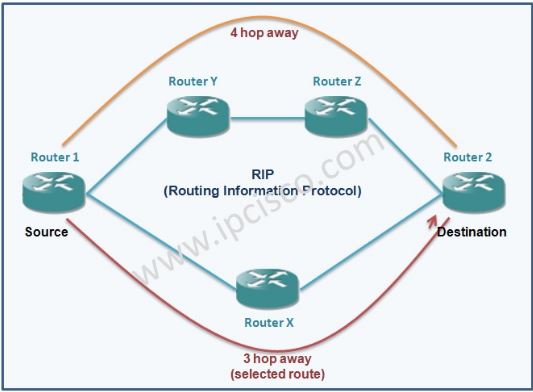What is Routing Information Protocol (RIP)? - Understanding RIP Routing:
RIP is a Part of Interior Gateway Protocols.
A Hop Count of “16” considers as an infinite distance. The path is considered remote. To prevent the spread of incorrect routing information, RIP implements the followings:
• The divided horizon.
• The poisoning.
• Path Retention Mechanisms.
In most network environments, RIP is not the ideal option for routing. As its union and scalability lack as compared to:
• EIGRP.
• OSPF.
• IS-IS.
However, it is easy to configure. As RIP does not require any parameters other than other protocols.
RIP uses UDP (User Datagram Protocol) as the transport protocol. Specified the reserved port number "520".
Basics of Routing Information Protocol:
1. Periodic Updates:
As we discuss before in the interior gateway protocol, all routers transmit their routing tables to routers directly connected to their interfaces.
In the case of RIP, it sends periodic updates every 30 seconds to all the other routers directly connected to it.
Even if there are no changes to the network, these updates are sent every 30 seconds.
Updates are sent only to interfaces configured in a router.
In addition, the update is sent periodically as a broadcast (255.255.255.255) to all hosts.
2. Administrative Distance:
Routers use administrative distance as a parameter when sending packets from one router to another.
This is a special number linked with each routing protocol.
Which allows a router to know which routing protocol is running another router.
Some administrative routings have been assigned to different routing protocols.
For RIP, it is 120.
Therefore, when another router receives the update and reads the administrative distance, it learns, the other router is running the protocol.
Routing Information Protocol Limitations:
1. Classful Routing:
RIP uses classful routing.
It does not support classless routing.
For example, if a network connected to a router, running RIP uses VLSM, all nodes/hosts on that network must use the same network mask.
2. Router Authentication:
There was no validation support in RIP version 1, which made the routers vulnerable to attack.
With version 2 of RIP, MD5 authentication entered the site.
In place of the plaintext password, the encrypted passwords were used for authentication.
Router authentication is used when a router receives a path update from the nearby router.
However, other mechanisms have been applied to prevent incorrect information from being filled up with other routers in RIP v2.
3. Split Horizon Route Advertisement:
To avoid routing loops, routers do not transmit the update on the interfaces from which they receive an update.
4. Route Poisoning with Hold down timer:
The concepts of route poisoning and standby timers are used to avoid packet looping.
To ensure, no routers send a packet to an invalid router.
Scenario:
When a router, such as a router A, detects, one of the networks directly connected to its interface is inactive, establishes its distance as 16 (the number of hops of 16 is counted as infinite in RIP) and spreads the update to others connected routers.
It may take some time on the web for the poisoned message on the route to reach all the other routers.
In the meantime, the router, promoted the message, in this case, router A, would not accept any update from any other router until the waiting timer expires.
Once the standby timer has expired, the router starts accepting updates from other routers.
RIP Routing Table:
A router running the RIP protocol maintains the following set of information about each node:
• IP address: the destination IP address.
• Gateway: the first gateway along the way to the destination.
• Interface: the interface of the router to which the router is connected.
• Metric: at a distance from the number of hops in which another router is located.
• Timer: the time of the last update of the entry.
RIP Timers:
The routing protocol uses different timers to track other nodes and updates.
Here is a list of timers used by RIP:
1. Update Timer:
The update timer is the frequency with which each active router causes its routing table to be transmitted to each other directly to the router connected to its interfaces.
RIP has the update timer set to 30 seconds by default.
2. Invalid Timer:
The invalid timer comes into play when one of the routers in the network has been marked as unreachable.
The router is marked as unreachable and invalid, configuring its jump distance as 16.
While the path is still stored in the routing table.
The connected router still waits a period of 180 seconds or six refresh periods (30 seconds x 6 = 180 seconds) before marking the router as poisoned as unreachable.
3. Flush Timer:
The Flush timer, as it appears from its name, is used to delete an entry from the routing table.
After a given router has been marked as invalid with the invalid timer.
4. Hold down Timer:
Hold down timer together with the poisoning properties of the RIP path to make sure there are no loops in the network.
When the router stops, a router waits another 180 seconds for the unreachable router to respond/send some updates before it can not be reached.





0 Comments